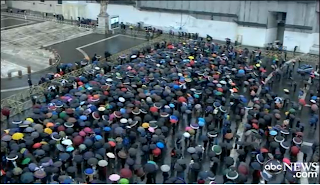Often times when a tornado has been confirmed for a certain city/area,
you will hear the rating that is given for it as well. This rating is used to
let people know how bad of a tornado it was. The scale is called the Enhanced
Fujita Scale, and it goes from zero to five, with an EF5 being the worst
tornado damage and highest wind speeds. However, sometimes it is hard to
visualize what that damage can look like. So above and below are images that
show you what each scale category looks like.
EF0
This category has wind
speeds of 65-85mph. The lowest tornado rating, EF-0, is reserved for minor
damage. Above, an EF-0 tornado peeled back parts of the red roof (picture
above) on a chicken barn in Ringgold, Georgia. These weak tornadoes usually
cause only light damage to well-built homes. They may peel back gutters or
siding, snap branches or uproot shallow-rooted trees.
EF1
This category has wind speeds of 86-110mph. Twisters of
the second-lowest rating can still wreck smaller structures, like the roof of
this church in Lyons, Georgia (seen below). Typically, EF-1 twisters strip away
roofs, flip mobile homes, blow off doors and shatter windows. And even though
these tornadoes are on the lower end of the scale, they can still be deadly. Mobile homes will slide off their foundation and can roll or flip
over, although they will remain intact. However, they can still be death traps
since trees can crash through them or the homes can roll and pin people
underneath. In fact, in the Southeast, often called Dixie Alley, there are
many manufactured homes, which is one reason that our region has a high number
of tornado-related deaths.
EF2
This will have wind speeds of 111-135mph. EF-2 tornadoes are when things get serious. These
strong storms can tear the roof off a house (picture below from Normantown, GA),
shift a house's foundation, snap large trees of 1ft. in diameter or larger,
lift cars off the ground and shoot boards like missiles. Mobile homes will be destroyed
like in the picture below from Normantown, GA from back in 2008. Apartment
buildings will experience uplift of their roof deck and suffer significant loss
of roofing structural materials.
EF3
Wind speeds of 136-165mph. An
EF-3 tornado is strong enough to destroy entire stories of well-constructed
houses, knock over trains, rip the bark from trees and toss heavy cars. Apartment buildings will suffer
the collapse of their roof structure, and will cause the collapse of most walls
on the top floor, like this one from Montgomery County, GA (seen below).
EF4
Wind speeds of 166-200mph. These tornadoes are strong enough to level sturdy houses, and rocket cars and
other large objects. Apartment buildings will suffer the
destruction of their top two stories. Hattiesburg, MS just recently experienced an EF4 back in February, and the tornado flattened several streets in the community (image seen below).
EF5
This category will have wind
speeds of over 200mph. These tornadoes, while relatively uncommon, are the most powerful. These twisters are
strong enough to blow away big houses and collapse tall buildings. The slabs of traditional homes
will be swept clean and apartment buildings will be completely destroyed. Two
years ago the town of Joplin, Missouri was forever changed by an EF5 tornado. An estimated $3 billion in damages, and over 150 fatalities were blamed on one single tornado.
Another EF5 tornado demolished the town of Greensburg, Kansas back in 2007. The massive twister leveled at least 95 percent of the city and killed 12 people.
Sources: Our Amazing Planet, NOAA, NWS, Hattiesburg American, Chattanooga Times Free Press, eHow, AP

















